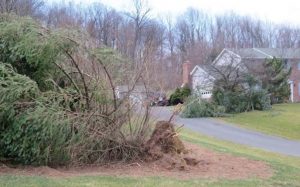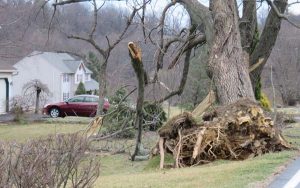
 The late-winter storm that blew through Lancaster County caused incredible damage in many areas. Property owners are now faced with the fact that trees will need to be replaced. What follows is advice on making that determination and taking the necessary steps to replace a tree.
The late-winter storm that blew through Lancaster County caused incredible damage in many areas. Property owners are now faced with the fact that trees will need to be replaced. What follows is advice on making that determination and taking the necessary steps to replace a tree.
The unusual late-February storm caused widespread damage, particularly in northern areas where tornado-like, 90-mile-per-hour winds leveled barns and outbuildings and closed many roads for days due to huge trees that were uprooted. New roofs and building repairs are evident across that area of the county. Many of us will be spending the summer cleaning up our properties.
For homeowners who have trees with extensive limb damage, but can be saved aesthetically with proper pruning and management, or are in need of expert advice on whether a tree has become a hazard, be sure to contact a certified arborist. International Society of Arboriculture (ISA) professionals must pass extensive examinations and keep abreast of developments by attending seminars. Ask for their ID to make certain you have the benefit of a recognized professional. Also, confirm that they are insured.
Selecting Your New Tree (or Shrub) at the Nursery
Assuming you are selecting and planting a replacement tree yourself, I offer some caveats. Even if you are having the nursery do the planting for you (perhaps with larger specimens), I would strongly advise you to be present to oversee the process. Despite new thinking in the past decade, older planting practices often persist.
Depending on the nursery, the tree or shrub you select will either be in a container or with a root ball that is covered with burlap material. This is called “B&B” – balled and burlapped – in the trade.
We are naturally inclined to want to get the largest tree (height-wise) that we can afford, but it is a mistake to make a choice on that basis. It is the vigor of the roots that is most important. Often a smaller specimen will do better over the long term. A smaller, more vigorous plant will actually settle into your soil faster than larger, more expensive choices. Younger trees and shrubs have better chances of survival.
When shopping for containerized trees and shrubs, always slip the plant out of the container at the nursery to inspect the roots (if the salesperson objects, go somewhere else). The roots should be a light tan and not brown or dried-up. The plant should not be pot bound or have circling roots. Remember, too, if the plant was recently repotted, you are paying more for the larger pot size, not a larger root system.
Beware of weeds growing in the container. I have spent years trying to get rid of Bishop’s weed (Aegopodium podagraria) that tagged along unnoticed in a nursery pot.
Most nurseries are very vigilant, and it is unlikely you will buy a plant with a worrisome pest or disease. However, beware of notches in leaves that might indicate chewing insects hiding in the foliage that are hard to control. On the other hand, it is not unusual to have some leaves with spots of mildew, for instance, because nursery plants are often packed in tight rows and are subject to overwatering.
Planting Your Tree
Water container-grown plants thoroughly and allow them to drain prior to planting.
Remove your plant from the container and inspect the root ball for circling roots. Tease these out to encourage lateral growth. Many arborists advise cutting vertically about an inch deep around the root ball to encourage new root growth.
Dig a square hole at least 3 times the root ball’s width, but only as deep as the bottom of the root ball. There is no need to go deeper.
Square? Experts point out that roots follow the sides of a square hole until they reach the corners where they are forced to grow into undisturbed soil. In a round planting hole, they can circle and never grow out. Do not loosen the soil at the bottom of the hole. However, if you have heavy soil, ensure the sides of the hole are not firm but loose.
It is very important to find the root flare – the point at the base of the trunk from which the topmost roots emerge. You might have to expose it by scraping some soil from the top of the root ball. The root flare should be level with the undisturbed ground or even 2 inches higher to allow for settlement. If it is sitting too low, add soil underneath the root ball until it is at the right level. This is very important. A common mistake we home gardeners make is planting trees too deep. As a result, they suffer from lack of oxygen and expand slowly since most new roots grow sideways in the top 12 inches of soil.
If the tree is B&B, cut the cords and remove any burlap that remains exposed so that the ball of soil is fully exposed. The small amount of fabric under the root ball will decompose. You might be told that it is unnecessary to remove the burlap, but this is bad advice for several reasons. These days the fabric and cords are not always natural burlap, but rather burlap-appearing plastic materials that will never decompose, thus preventing the normal growth of the roots. The tree will be doomed. Additionally, if some of the wrapped burlap remains above ground, it acts as a wick and draws moisture from the root ball.
The loosened roots should be spread out evenly all around.
It is no longer recommended to add either fertilizer or extra organic matter to the planting hole. Enriching the area around the root ball discourages roots from exploring sideways and delays establishment.
Be sure the tree is upright by inspecting it at a distance from all directions. Pack the soil over the roots a few inches at a time and be sure to eliminate any air pockets by sifting the soil between the roots and firm the soil with your fist. Finally, water thoroughly to settle the soil around the roots.
Smaller trees probably do not need stakes or even minimal support. Swaying in the wind slightly actually stimulates root vigor. Stakes for larger specimens do not need to be more than 2 feet above the ground. It is best to use two upright stakes on opposite sides of the trunk, inserted beyond the side of the root ball. Secure with a padded tie to minimize bark injury.
If your garden is visited by deer, be sure to protect the trunks of young trees from rutting in early fall with some sort of tree guard or temporary plastic fencing.
I’d also encourage you to re-read my article on proper mulching practice. You can find it at lancastercountymag.com.
My Favorite Shade Trees
Red maple (Acer rubrum) is my strongest recommendation because it is tough and tolerant of many growing conditions and has a brilliant deep-red fall color. ‘Red Sunset’ and many other cultivars are available.
Sugar maple (Acer saccharum) displays beautiful fall colors of yellow, orange and red. It requires rich soils and is not as tolerant of our hot summers as red maple.
White oak (Quercus alba) should be in every large garden! Unfortunately, it is difficult to find at nurseries.
Scarlet oak (Quercus coccinea) tolerates many soil types and delivers dark-red fall color.
Pin oak (Quercus palustris) is a fast grower with a pyramidal shape. It tolerates wet soil. Remember the lower branches will descend.
Northern red oak (Quercus rubra) tolerates pollution and compacted soil and delivers gorgeous red fall color.
Bur oak (Quercus macrocarpa) is long-lived, large and slow-growing. Like all oaks, the acorns are of major benefit to wildlife.
Linden (Tilia americana) is regal and wide-spreading. A favorite of honey bees.
Tulip tree (Liriodendron tulipifera) is stately with upright habit, provides stunning golden fall color, and magnolia-like orange, yellow and green flowers in late spring.
Gingko (Gingko biloba) is the oldest tree on earth, unchanged for 200 million years. It’s tolerant and pest free. Fan-shaped leaves turn yellow in fall and drop all at once. Perfect for urban environments. But, buy only trees labeled as male; females produce messy, stinky fruit. ‘Princeton Sentry’ and ‘Autumn Gold’ are good choices.
Do not be seduced by “fast-growing” trees like the wretched Bradford pear or silver maple. They will often have poor branching structure, age poorly and eventually split in ice storms.





SHARE
PRINT